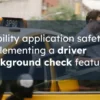When you hop into a taxi, whether it’s for a quick trip across town or a longer journey, safety is paramount. A safe taxi ride encompasses several key factors, including the driver’s competence, the condition of the vehicle, adherence to traffic laws, and your comfort and peace of mind during the ride. Knowing what to expect from a safe taxi ride can not only help you feel more secure but also empower you to make informed decisions when choosing transportation services.
This blog will delve into what defines a safe taxi ride, the responsibilities of both taxi drivers and passengers, and how to identify and ensure a safe journey from start to finish.
A Professionally Trained and Vetted Driver
One of the most important aspects of a safe taxi ride is having a trained and qualified driver. The driver is responsible for safely navigating the vehicle, adhering to traffic rules, and making sure passengers reach their destinations without incident. Here’s what you should expect from a professional taxi driver:
Proper Licensing and Training
A safe taxi driver will possess the appropriate licenses required by the local or national government. In most countries, taxi drivers are required to have a specialized commercial driver’s license, and they may also undergo additional training in customer service, local geography, and safe driving practices. This ensures that they are knowledgeable about the rules of the road and are qualified to transport passengers safely.
Tip for passengers: Don’t hesitate to ask your driver about their credentials or look for their license, which is often displayed on the dashboard or rear window. If you’re ever in doubt about a driver’s qualifications, you can verify their licensing with the taxi company or local regulatory authorities.
Background Checks
A safe driver has undergone thorough background checks, including a review of their criminal history and driving record. These checks ensure that drivers have no history of violent behavior, reckless driving, or other criminal activities that could endanger passengers.
Tip for passengers: In many cities, ride-hailing apps or taxi companies provide driver profiles that include a photo, name, license number, and ratings from previous passengers. Reviewing these details can give you peace of mind about the driver’s reliability and safety.
Clear Communication and Professionalism
A safe taxi ride is not just about the technical aspects of driving; it’s also about how the driver interacts with you. Professionalism in a taxi driver includes being courteous, respectful, and maintaining clear communication about the route and destination. A safe driver will ask you if you have a preferred route and confirm your destination before beginning the ride.
Tip for passengers: If a driver exhibits aggressive or inappropriate behavior, you have the right to ask them to stop the vehicle and let you out, or you can contact the taxi company or ride-hailing platform to report the behavior.
A Well-Maintained Vehicle
The condition of the taxi you enter is just as important as the driver’s qualifications. A safe taxi ride requires that the vehicle be in good working order, with all safety features intact and functional. Here’s what you should expect when it comes to the condition of a taxi:
Up-to-Date Maintenance
A safe taxi should undergo regular inspections and maintenance. This includes checking the brakes, tires, lights, engine, and other essential systems to ensure that everything is in proper working condition. Vehicles that are poorly maintained can lead to mechanical failures, accidents, or breakdowns on the road.
Tip for passengers: If you notice any unusual sounds, odors, or mechanical issues in the taxi, such as squeaky brakes or an engine that struggles to start, don’t hesitate to ask the driver about it. You can also report maintenance issues to the taxi company or platform after your ride.
Functional Safety Features
The vehicle should have all necessary safety features in working condition, including seatbelts, airbags, and functional door locks. Seatbelts are especially important, as they significantly reduce the risk of injury in case of an accident. A well-maintained taxi will also have properly functioning lights and indicators, so the driver can safely navigate the road and alert other drivers to their movements.
Tip for passengers: Always buckle your seatbelt, even on short rides. If a seatbelt is broken or missing, request another vehicle, as this is a basic safety requirement that should never be overlooked.
Cleanliness and Comfort
While cleanliness may not directly affect the safety of a ride, it’s still an important aspect of the overall experience. A safe taxi ride is one where passengers feel comfortable, and that includes sitting in a clean, tidy, and hygienic environment. Additionally, a clean vehicle can indicate that the driver and taxi company take pride in maintaining their vehicle, which could also reflect their commitment to safety.
Tip for passengers: If a taxi is excessively dirty, you can request another one. Most ride-hailing platforms and taxi companies have quality standards for cleanliness, and reporting a dirty taxi can help maintain those standards.
Adherence to Traffic Laws and Safe Driving Practices
A key element of a safe taxi ride is the driver’s ability to follow traffic laws and prioritize safe driving at all times. Whether it’s obeying speed limits, yielding the right of way, or using signals appropriately, a safe driver ensures that the rules of the road are respected. Here are some specific safe driving practices to expect:
Obeying Speed Limits
A safe driver will always adhere to the speed limits, even if you’re in a hurry. Speeding not only increases the likelihood of accidents but also reduces the time the driver has to react to sudden changes on the road, such as a pedestrian crossing or an unexpected stop.
Tip for passengers: If you notice your driver exceeding the speed limit or driving recklessly, it’s okay to ask them to slow down. Your safety should always be the top priority.
Defensive Driving
Defensive driving involves being aware of potential hazards on the road and reacting to them in a safe manner. A defensive driver maintains a safe following distance, keeps an eye on other vehicles, and anticipates potential problems, such as a driver suddenly stopping or swerving into another lane.
Tip for passengers: Pay attention to your driver’s behavior. If they are tailgating, weaving in and out of traffic, or engaging in other risky behaviors, you may want to ask them to drive more carefully.
Avoiding Distractions
A safe taxi ride requires the driver to remain focused on the road at all times. Distractions, such as using a mobile phone, eating, or engaging in lengthy conversations, can impair the driver’s ability to react quickly to changing conditions. Professional drivers know how to manage distractions and keep their attention on the road.
Tip for passengers: If your driver is constantly checking their phone or not paying attention to the road, you have the right to ask them to stop. Reporting such behavior can also help prevent future safety issues.
Adherence to Traffic Signals and Signs
Following traffic signals and signs is a fundamental part of road safety. A safe driver will obey all stop signs, traffic lights, and yield signs, and will not attempt to run red lights or make illegal turns. Ignoring traffic signals can lead to collisions and endanger passengers.
Tip for passengers: If your driver runs a red light or ignores a stop sign, it’s a serious safety concern. Let them know that you are uncomfortable with that behavior, and report it to the taxi company or platform if necessary.
Secure Payment and Transparency
Safety in a taxi ride is not limited to just physical security; it also extends to financial security. Transparent pricing and secure payment methods are critical components of a safe and trustworthy taxi service. Here’s what you should expect in terms of payments:
Clear Fare Structure
A safe taxi ride includes a clear and transparent fare structure. Whether you’re using a meter-based taxi or a ride-hailing app, you should have a good understanding of the cost of your trip upfront. This eliminates the risk of overcharging or surprise fees at the end of your ride.
Tip for passengers: If you’re in a meter taxi, make sure the meter is running properly and starts at the base fare. In ride-hailing apps, the fare is usually displayed before you book the ride, providing peace of mind that you won’t be overcharged.
Secure Payment Methods
Most modern taxi services and ride-hailing apps offer secure and convenient payment methods, including credit cards, digital wallets, and cashless transactions. These payment options reduce the risk of theft and ensure that your financial information is protected.
Tip for passengers: If possible, use cashless payment methods to avoid carrying large amounts of cash. Also, verify the transaction before confirming payment to ensure the correct amount has been charged.
Passenger Rights and Comfort
A safe taxi ride isn’t just about the driver following traffic laws and maintaining a clean vehicle—it’s also about ensuring that passengers feel respected, comfortable, and in control of their journey. Knowing your rights as a passenger can make a significant difference in your experience:
Right to Choose the Route
As a passenger, you have the right to choose the route you prefer, whether it’s the fastest, shortest, or most scenic. While taxi drivers are expected to know the best routes, they should always respect your preferences and take your desired route when reasonable.
Tip for passengers: If you have a preferred route, let the driver know before the journey begins. If the driver refuses to follow it without a valid reason, this could be a red flag for unprofessionalism.
Right to Feel Safe
Passengers have the right to feel safe throughout the journey. If at any point you feel uncomfortable or unsafe due to the driver’s behavior, vehicle condition, or driving style,





